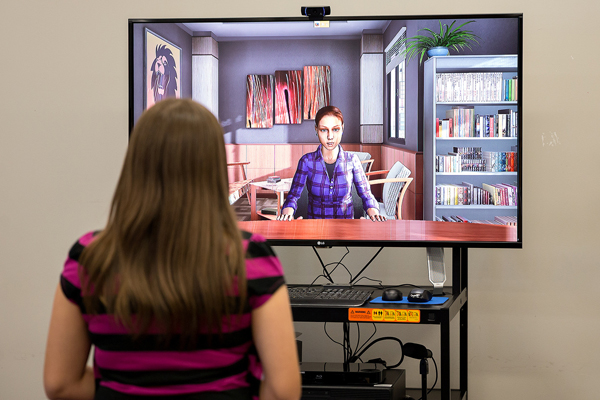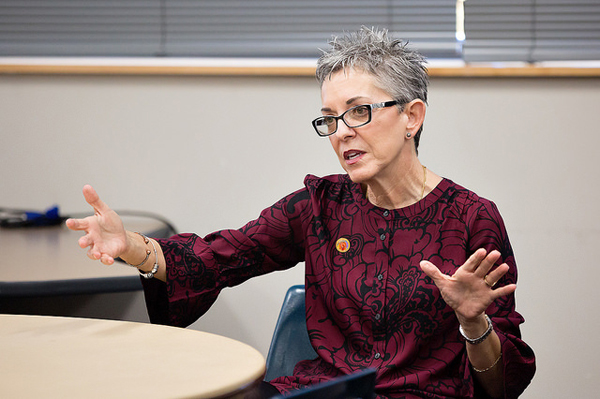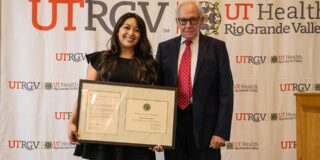- La Feria Native Soon To Retire From The Military This Summer
- Senior Eneece Avila Takes Pride in her State Title
- Dr. Noemi Infante, Harlingen Medical Center Open New Women’s Clinic
- Santa Rosa Cameron County Park Partially Reopens
- Santa Rosa Takes to Regionals Meet in Kingsville, Tx
- Long-Standing Nexstar Tower in La Feria Decommissioned
- Lionettes Powerlifting Meet
- Local Business Holds Event to Benefit RGV Shriners Club
- Knights of Columbus Holds it’s 30th Annual Golf Tournament
- KGBT Tower Dismantled
UTRGV’s Future Educators Now Can Sharpen Skills Via Virtual Environment
- Updated: December 9, 2016

Kimberly Prince, a UTRGV music education major, participated in a Mursion virtual reality parent-teacher conference scenario, during a demonstration hosted Nov. 30, 2016, by the UTRGV College of Education and P-16 Integration at the Education Complex on the Edinburg Campus. Photo: Paul Chouy/UTRGV
by Melissa Vasquez
EDINBURG, TEXAS – Before students from The University of Texas Rio Grande Valley College of Education and P-16 Integration get into a real-life classroom setting, they now will have a chance to fine-tune their craft with some feisty, challenging student avatars in a virtual reality environment.
Since spring 2016, more than 70 UTRGV students have harnessed the power of virtual simulation, thanks to the college’s license purchase of Mursion’s Software for Educator Preparation, which designs and delivers custom simulation scenarios in-house for students and faculty.
Dr. Patricia Alvarez McHatton, dean of the College of Education and P-16 Integration, said the software offers students and faculty a unique mixed virtual reality environment, where they can interact in real-time with student and parent avatars in scenarios ranging from behavior management in the classroom, the teacher introducing new content, or a parent-teacher conference.
“We are one of the first universities in the country that was able to secure its own license,” McHatton said. “By having our own license, it gives us the opportunity to have more flexibility in being able to do the work that we want to do.”
According to the Mursion website, the university is “the first site capable of autonomous rapid prototyping of virtual reality scenarios. UTRGV is paving the way for the next generation of professional learning simulations in teacher education.” UTRGV is one of more than 80 universities and other programs to use the software for preparing K-12 teachers.
With the software, UTRGV students and faculty will be able to rehearse instructional techniques, including managing classrooms, working with children with special needs, and practicing specific instructional routines relevant to a particular subject area.
McHatton compares this virtual reality student training to that of pilots who are required to log thousands of hours on a simulator before they can fly.

Dr. Patricia McHatton, dean of the UTRGV College of Education and P-16 Integration, led a demonstration of the university’s Mursion virtual reality software, Nov. 30, 2016, on the Edinburg Campus. The virtual scenarios provide a chance to experience real-life classroom challenges “all in a safe environment where they can make mistakes,” McHatton said. Photo: Paul Chouy/UTRGV
“We believe children are worth more than a million dollar plane. So what this does is that it provides our teacher candidates, and even our future leaders, the opportunity to practice and learn what it is they need in regard to content, pedagogy, classroom management and those types of things, all in a safe environment where they can make mistakes,” McHattton said.
Students can pause the simulation and get feedback from their peers, teacher or coach, McHatton said, and then reenter and learn from their mistakes.
“By the time they enter the classroom, they really are very comfortable and much more secure in their ability to be able to engage kids,” she said.
McHatton said the sky’s the limit when it comes to the scenarios that can be created to assist future educators.
“It’s up to your imaginations how you want to use it,” she said.
To showcase the new software, McHatton held a demonstration for the university community and public to experience the interaction between students and avatars on Wednesday, Nov. 30, on the UTRGV Edinburg Campus. The software also is being used on the Brownsville Campus.
Music education major Gil Ballesteros, 35, was among three UTRGV students who demonstrated how he interacted with a difficult parent during a parent-teacher conference. Ballesteros said it was tough, but it did not discourage him from going into the teaching field.
“It’s pretty interesting how lifelike the responses were from those avatars. It’s like nothing I have ever experienced before. It’s a great tool for all education students to try out,” Ballesteros said.
Ballesteros has used the software a couple of times already, but said his first reaction was shock at how the avatars responded to student’s facial gestures or even remarked on their clothing.
“I’m glad UTRGV is doing this because I get to experience this,” he said.
Dr. Veronica Estrada, a professor in the Department of Teaching and Learning, began using the software in the summer. The virtual environment will help students hone their interpersonal communications skills, improve their vocabulary development – in particular their teacher education vocabulary, she said. And, it will demonstrate how they come across in terms of behavior management.
“I just want them to be confident,” Estrada said of the students. “I want them to feel like second-year teachers when they are student teaching as a result of going through all these practices and rehearsals.”
In addition to UTRGV students and faculty, McHatton said, UTRGV departments like Human Resources and the School of Medicine also are making good use of the Mursion software. The School of Medicine has used it for doctor-patient scenarios, and HR has used it in staff development sessions. McHatton encourages school districts throughout the Rio Grande Valley to contact the College of Education and P-16 Integration if they would like to use the software for professional development.
“We have a mobile unit that we can share throughout the region, and with the districts, in improving their teachers,” she said.
To learn more about the Mursion software, contact the College of Education and P-16 Integration at (956) 665-3627 (Edinburg Campus) or (956) 882-5708 (Brownsville Campus).






